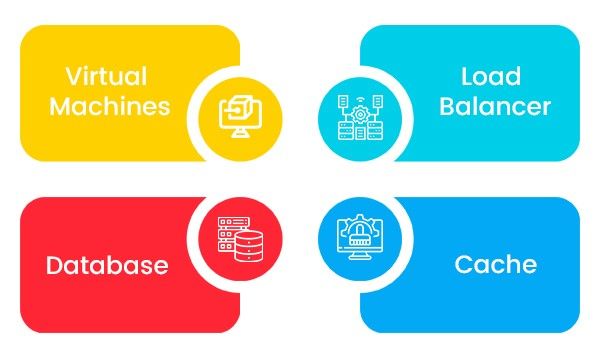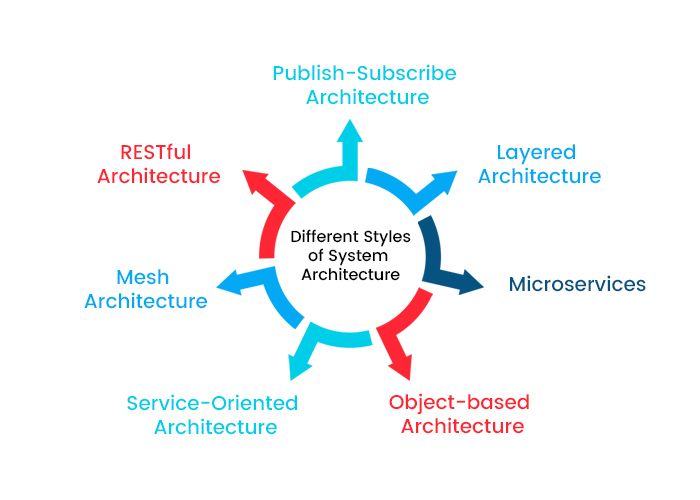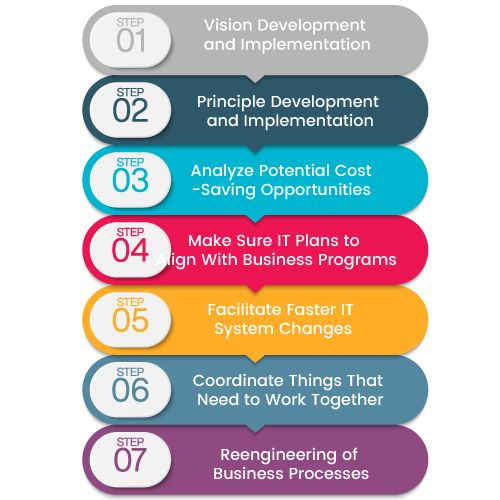
A comprehensive Understanding of System Architecture and its Multiple Elements
Introduction
As IT continues to evolve, it is crucial to have a robust network and a strong system. Goals that surround a company's procedures will lead to growth, but this can not be the end of it. Technology needs to develop in a way that meets these goals and is also correctly designed, deployed, and maintained. This article aims to give you the necessary context regarding the system architecture, its types, and its benefits.
What is System Architecture?

The system architecture describes the physical placement of software components. You can place two closely related components together on different machines. Location will also influence a component's performance and dependability. The resulting style eventually reflects the connection between the elements, the exchange of data, and their work as a cohesive system.
A system's architecture indicates how it works and interacts with different approaches and the external environment. It describes how all system components interconnect and how data links between them.
As a whole, the architecture of a system shows its vision in terms of its interactions, functions, and structures. Architecture can function as a guide or a framework for designing and developing a new system or can assist in defining a project's goals.
Basic Concepts of System Architecture

You can understand a system architecture easily if you know these basic concepts:
● Latency: In data transmission, latency refers to the time required in communication between two points. It is determined by the physical distance the data has to cover.
● Bandwidth: In computing, bandwidth refers to the speed at which data is transferred for a fixed period and is usually measured in megabits per second (Mbps) or gigabits per second (Gbps). Inherently, the word bandwidth refers to the width of a communication band, which determines transfer speed.
● Throughput: The throughput of a system refers to how much information it can process in a given timeframe. Various aspects of computer, network, and organizational techniques are subject to this concept.
● Horizontal and Vertical Scaling: To cope with growing demands, horizontal scaling entails adding additional servers or machines. The solution to problems like traffic overload is to add another server.
On the other hand, adding more resources to a system to meet demand is vertical scaling. In contrast to horizontal scaling, vertical scaling describes an increase in the power of your existing machines.
Elemental Composition of System Architecture

Developing a system involves selecting the appropriate components to address the challenge at hand. Various cloud providers offer thousands of different features and stacks. Here we will discuss some of the fundamental elements of system architecture.
● Virtual Machines: Virtual machines (VMs) are computer systems based on physical hardware but featuring their CPU, memory, network interface, and storage. A single piece of hardware, such as a server, can support multiple VMs, which are isolated from the rest of the system.
● Load Balancer: In the context of distributed computing, a load balancer distributes traffic among multiple servers by acting as a reverse proxy. Increasing the number of servers horizontally makes it easier to scale.
● Database: During the operation of an application, data is stored and retrieved from a database. DBMSs, aka, databases because they manage physical data storage.
● Cache: The concept of caching in computing refers to storing small amounts of data, often transient, to make them more accessible than directly accessing them. Data caches can be used to repurpose previously procured or computed data effectively.
Different Styles of System Architecture

A variety of architectural styles are available depending on the application. In addition, distributed systems become more complex as you build more connected, complex systems.
To achieve this, one requires process improvements such as streamlined communication.
An evolutionary sequence can be seen in object-oriented, service-oriented, microservice, and mesh architectures. Service-oriented architectures (SOAs) and microservices are made possible by object-oriented programming methodologies, not architectural styles.
Following are some of the styles in system architecture:
Layered Architecture
Layered architecture is based on the organization of components in layers. Higher-level components are responsible for making down calls. On the other hand, a component at the lower layer is capable of making calls, and it can usually only respond to calls at the higher layers.
Upon returning the information to the data layer, the processing layer sends it to the interface for viewing and editing. Despite feeling cohesive, it has three (or more) distinct layers, broken down into three components. It is up to the system architecture to decide whether each layer should be located on a different machine.
Object-based Architecture
A monolithic app is generally built using object-oriented programming. It is also implemented in more modern architectures—the logical components of the monolith group into objects. Although objects are diverse components, they usually interconnect and are very difficult to isolate. Monoliths can be organized and managed through object-oriented methods.
Objects have their own set of data encapsulated within their state. Data storage is one way to differentiate stateful from stateless applications. Here, the state refers to the data. An object's method is how it operates on data.
Service-Oriented Architecture
Objects are the building blocks of SOAs, encapsulating services into independent units. An independent, self-contained service uses other resources and solutions as well. The interfaces communicate using "messages" sent over the network.
Microservices
Compared to SOA services, microservices are smaller, loosely coupled, and lighter. Their ability to reduce time to market is their most significant advantage from a business perspective.
With microservices, developers are less concerned about architectural details, allowing them to update services without worrying about designing and mapping the interactions and interfaces. Furthermore, developers can choose any programming language they wish to use. In addition to enhancing program speed, picking the apt language will reduce time-to-market.
Mesh Architecture
The mesh technology is efficient even when volatile or highly unstable environments compromise the integrity of connectivity between components. Many of the components don't even connect directly. Communication occurs instead over multiple "hops" via other components in the system.
Object-oriented programming has evolved over the years into SOAs, microservices, and mesh architectures, but that doesn't make this model obsolete. The object-oriented approach separates blocks within components or monoliths. There was and is still a use for this methodology. You can design and develop object-oriented microservices in which objects are the components of microservices.
RESTful Architecture
Web-native architectures like REST have widespread adoption on the Web. A distributed system consists of bountiful resources that individual components manage. A standard interface and reduced commands make it easier to develop compatible systems.
Internet systems are hugely distributed, and REST simplifies the process of dealing with them.
It is still possible for developers to express whatever they need despite these restrictive commands. This is because the URL contains all the information about operations since it is a descriptive resource address.
Publish-Subscribe Architecture
Publish-subscribe architectures enable processes to join or leave easily with a more loosely coupled design. Service communication is what makes a difference. As opposed to calling and receiving a response, services typically send one-way, asynchronous messages without targeting a specific recipient. Configuration is done by the configurator, administrator, or developer. A receiver can sometimes opt into a message by themselves.
Mobile applications in which network reliability is a concern are most likely to benefit from pub/sub. A mobile app that relies on service calls experiences poor performance once connectivity is lost.
Benefits of System Architecture

Correctly utilizing the system architecture can change your business game. Following are some of the upsides that come with System architecture:
Vision Development and Implementation
Architectures are helpful for assessing the overall current state of IT and for developing a vision of where the organization should be heading in the future. By agreeing to this, people will begin to work towards the same goal, pilot project experiences will be utilized in more ways, and procurements will conform to this strategy.
Principle Development and Implementation
Identifying and distributing certain principles that guide IT behaviour in an organization is the purpose of architecture. The organization faces difficulties in identifying and communicating basic principles without architecture. People can develop systems and make purchases that are counter to the organization's objectives without principles. Architects can have high-level principles for the entire agency as well as guidelines for individual parts of the architecture.
Analyze Potential Cost-saving Opportunities
Architectures assist organizations in analyzing their existing IT and identifying cost-saving opportunities. It is possible, for instance, to use one database system instead of multiple sources of data, which would reduce software and support costs. A limited number of desktop systems could reduce support costs and complexity. It is possible to determine whether other standards would be beneficial by analyzing the baseline architecture, or it might indicate that they would be detrimental and should be avoided. It may make more sense to reduce technology costs by optimizing internal and contract staff rather than the technology itself.
Make Sure IT Plans to Align With Business Programs
A computer system may run fairly independently in some organizations, with business processes using the system without much involvement in planning changes. Cases like this have led to some nightmare situations. An architecture that focuses on business processes can help refocus thinking along the lines of business.
Facilitate Faster IT System Changes
Business needs, legislative requirements, and other factors are driving the need for systems to evolve rapidly. Understanding how the affected system interconnects with programs, other technology areas, and so on can assist in planning for change. A system change, for example, should be considered from the perspective of all users, and reflect this in the architecture so that smaller users are not overlooked.
To ensure that changes to IT systems are properly planned, it is helpful to have models of the IT systems in place. It is easier to plan and less likely to make mistakes when you can outline complex situations in a clear and accessible way using architecture.
Coordinate Things That Need to Work Together
Most often, IT planning occurs at a local level without considering the needs of the larger organization. By analyzing how systems need to communicate, exchange data, etc., architecture can help identify any necessary changes.
Reengineering of Business Processes
Any analysis of business processes must take into account how IT works. The architecture allows you to analyze data and workflow easily to understand how IT can make business processes more efficient and effective.
Explaining the needs and benefits of IT systems to management and budget personnel
Architecture easily illustrates an organization's business processes and needs. Obtaining support for the necessary resources may be easier with this approach.
Who is a System Architect?

A system architect is an expert in both business and technology. By analyzing business objectives, and technical solutions along with making recommendations, they help clients take their business goals to the next level and scale their businesses seamlessly.
A system architect or solution architect knows what components to select for a particular application, makes trade-offs, and keeps an eye on bottlenecks. The more experience a system architect has, the better they will be at system architecture because it is an open-ended problem with no definitive answer.
Just as mechanical engineers should understand machines in detail, a system architect should be capable of understanding:
● What is the maximum stress a computer system can handle?
● How to use the system?
● What are the design requirements for a successful system?
Roles of a System Architect
1. System architects define and design the best IT strategies and approaches in the most complex and long-term business plans and goals.
2. Define those outcomes in terms of products, processes, and functions.
3. Select an architecture that will help them achieve what they have set out to do.
4. Understand the interaction, integration, and interfaces between software, hardware, and users.
5. To meet mid-term departmental and functional objectives, system architects recommend tools, frameworks, hardware, software, and other IT elements.
6. The role of a system architect consists of consulting and educating project teams regarding specific software, hardware, and other aspects of IT projects.
7. Provide advice to project teams on how to implement their recommendations and software development solutions.
Who is a System Engineer?

An organization's system engineer prepares plans for how it's software systems will integrate, support, and maintain them. The process requires more thought and effort than simply scanning through software lists and selecting the one that interests you most.
A Systems engineer takes into account reliability, longevity, maintainability, risk management, and more when specifying requirements from users, developers, and managers. Identifying organizational problems and finding the most credible and productive solution is the role of a system engineer.
Roles of a System Engineer
1. Assessing the challenges of the system and determining the best solution for the project.
2. The process of successfully finishing a project.
3. Interdisciplinarity in team management.
4. Keeping quality high while optimizing systems.
5. Managing systems, software, and operations through installation, configuration, testing, and maintenance.
6. Maintaining high availability of infrastructure and systems.
What is Web Application Architecture?

Throughout a Web application, there are multiple components, databases, middleware systems, user interfaces, and servers. An application's architecture describes how these components interact together. Alternatively, it acts as the connection between the browser and server that logically enhances the web experience and assists in the process of web development.
Having a well-thought-out web app architecture is essential to handling the varying loads and adapting to changing business requirements to enhance app performance even further. By dividing the structure into several smaller modules, you can tackle various Web development tasks simultaneously, which eventually reduces web development time. The overall structure modifies without affecting new functionalities.
What is Solution Architecture?

Solution Architectures guide software development projects which define the functional requirements and stages of implementation of software development solutions. A variety of enterprise architecture viewpoints draw upon its subprocesses.
Solutions architecture expands client requirements to include business requirements that have a technology component. By re-evaluating existing systems and assessing their long-term effects, these needs usually crystallize. Business analysts sometimes run these evaluations in conjunction with defining the problem. Next, solution architects identify Software Development solutions that address this need with a description of how they can be implemented.
Conclusion
System architecture plays an instrumental role in the design of an application. As described by application architecture, a software application involves a variety of components, data models, programming models, and a particular configuration of data. It also explains the web applications development and maintenance, including how to test and maintain it.
Designed for current and future users, application architecture should address both needs. To be sustainable, its architecture must be flexible enough to adapt to changes in technology and user needs. In addition, it must support the growth of the company in the future.
Popular Tags
Recent Posts
Smart automation for cash-strapped startups
The modern data trinity: How medallion architecture, RAG, and data lakes revolutionize enterprise intelligence
Accelerating AI-Driven Development with Docker’s MCP Catalog & Toolkit
Building Intelligent Agent Teams with Google's ADK: A Developer's Guide
We are at























